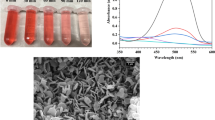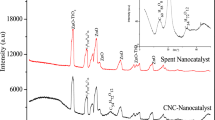Abstract
In the present study, the photodegradation performance of Methyl Orange (MO) by CA/ZnO hybrid aerogel was successfully predicted through numerical and mathematical modeling. A mathematic model and numerical simulation were developed via MATLAB and COMSOL Multiphysics software based on finite difference method (FDM) and finite element method (FEM), respectively. The experimental data were derived from the experimental tests for the photocatalytic degradation efficiency of MO from an aqueous solution in order to validate the simulation. Results demonstrated that there is a good agreement between experimental data and predicted numerical values using COMSOL and mathematical simulation. Also, the effect of diffusion coefficient on the photodegradation efficiency of different dyes such Rhodamine B (RhB) and Methylene Blue (MB) were investigated using FEM method. The FEM numerical results showed that the photodegradation efficiency of MO, MB and RhB dyes, were 94.71%, 92.21% and 90.36%, respectively. The outcomes can be employed as predictive tools for planning the photodegradation efficiency of various pollutants.
Graphic Abstract













Similar content being viewed by others
References
Nguyen DD et al (2019) Micron-size white bamboo fibril-based silane cellulose aerogel: fabrication and oil absorbent characteristics. Materials 12(9):1407
Wang C et al (2017) Preparation of carbon nanotubes/graphene hybrid aerogel and its application for the adsorption of organic compounds. Carbon 118:765–771
Yagub MT et al (2014) Dye and its removal from aqueous solution by adsorption: a review. Adv Coll Interface Sci 209:172–184
Tan L et al (2019) Synergistic effect of adsorption and photocatalysis of 3D g-C3N4-agar hybrid aerogels. Appl Surf Sci 467:286–292
Bolobajev J et al (2019) Metal-doped organic aerogels for photocatalytic degradation of trimethoprim. Chem Eng J 357:120–128
Wan W et al (2018) Monolithic aerogel photocatalysts: a review. J Mater Chem A 6(3):754–775
Chen S et al (2019) Robust three-dimensional g-C3N4@ cellulose aerogel enhanced by cross-linked polyester fibers for simultaneous removal of hexavalent chromium and antibiotics. Chem Eng J 359:119–129
Chen Y et al (2020) Effective photocatalytic degradation and physical adsorption of methylene blue using cellulose/GO/TiO 2 hydrogels. RSC Adv 10(40):23936–23943
Shah AA et al (2020) Facile synthesis of copper doped ZnO nanorods for the efficient photo degradation of methylene blue and methyl orange. Ceram Int 46(8):9997–10005
Xie M et al (2020) Facile fabrication of ZnO nanorods modified with RGO for enhanced photodecomposition of dyes. Colloids Surf A 603:125247
Islam MT et al (2020) Development of photocatalytic paint based on TiO2 and photopolymer resin for the degradation of organic pollutants in water. Sci Total Environ 704:135406
Ismael M (2020) Enhanced photocatalytic hydrogen production and degradation of organic pollutants from Fe (III) doped TiO2 nanoparticles. J Environ Chem Eng 8(2):103676
Kim T et al (2019) Facile synthesis of SnO2 aerogel/reduced graphene oxide nanocomposites via in situ annealing for the photocatalytic degradation of methyl orange. Nanomaterials 9(3):358
Costantino F et al (2020) In situ formation of SnO2 nanoparticles on cellulose acetate fibrous membranes for the photocatalytic degradation of organic dyes. J Photochem Photobiol A 398:112599
Cui L et al (2019) Electrospinning synthesis of SiO2-TiO2 hybrid nanofibers with large surface area and excellent photocatalytic activity. Appl Surf Sci 488:284–292
Shan R et al (2020) Photocatalytic degradation of methyl orange by Ag/TiO2/biochar composite catalysts in aqueous solutions. Mater Sci Semiconduct Process 114:105088
Suchithra P et al (2012) Mesoporous organic–inorganic hybrid aerogels through ultrasonic assisted sol–gel intercalation of silica–PEG in bentonite for effective removal of dyes, volatile organic pollutants and petroleum products from aqueous solution. Chem Eng J 200:589–600
Dassanayake RS, Rajakaruna E, Abidi N (2018) Preparation of aerochitin-TiO2 composite for efficient photocatalytic degradation of methylene blue. J Appl Polym Sci 135(8):45908
Li S et al (2018) Rapid photocatalytic degradation of pollutant from water under UV and sunlight via cellulose nanofiber aerogel wrapped by TiO2. J Nanomater 2018:1
Chen F et al (2018) 3D graphene aerogels-supported Ag and Ag@ Ag3PO4 heterostructure for the efficient adsorption-photocatalysis capture of different dye pollutants in water. Mater Res Bull 105:334–341
Long L-Y, Weng Y-X, Wang Y-Z (2018) Cellulose aerogels: synthesis, applications, and prospects. Polymers 10(6):623
De France KJ, Hoare T, Cranston ED (2017) Review of hydrogels and aerogels containing nanocellulose. Chem Mater 29(11):4609–4631
Ge X et al (2018) High-strength and morphology-controlled aerogel based on carboxymethyl cellulose and graphene oxide. Carbohyd Polym 197:277–283
Yang L et al (2020) Development of eco-friendly CO2-responsive cellulose nanofibril aerogels as “green” adsorbents for anionic dyes removal. J Hazard Mater 405:124194
Beh JH et al (2020) Cellulose nanofibril-based aerogel derived from sago pith waste and its application on methylene blue removal. Int J Biol Macromol. https://doi.org/10.1016/j.ijbiomac.2020.05.227
Pereira ALS et al (2020) Bacterial cellulose aerogels: influence of oxidation and silanization on mechanical and absorption properties. Carbohydr Polym 250:116927
Simón-Herrero C et al (2020) Utilization and reusability of hydroxyethyl cellulose alumina based aerogels for the removal of spilled oil. Chemosphere 260:127568
Khan HW, Moniruzzaman M, Elsayed Nasef MM, Bustam MA (2020) Ionic liquid assisted cellulose aerogels for cleaning an oil spill. Mater. Today: Proceedings 31:217–220
Jiao Y, Wan C, Li J (2015) Room-temperature embedment of anatase titania nanoparticles into porous cellulose aerogels. Appl Phys A 120(1):341–347
Tang C et al (2020) Shape recoverable and mechanically robust cellulose aerogel beads for efficient removal of copper ions. Chem Eng J 392:124821
Xu J et al (2020) Cellulose nanofibril/polypyrrole hybrid aerogel supported form-stable phase change composites with superior energy storage density and improved photothermal conversion efficiency. Cellulose. https://doi.org/10.1007/s10570-020-03437-7
Islam N et al (2017) High-frequency electrochemical capacitors based on plasma pyrolyzed bacterial cellulose aerogel for current ripple filtering and pulse energy storage. Nano Energy 40:107–114
Han S et al (2020) Cellulose-conducting polymer aerogels for efficient solar steam generation. Adv Sustain Syst 4:2000004
Li S et al (2020) Cellulose nanofibril-stabilized pickering emulsion and in situ polymerization lead to hybrid aerogel for high-efficiency solar steam generation. ACS Appl Polym Mater 2:11
Feng J et al (2016) Silica cellulose hybrid aerogels for thermal and acoustic insulation applications. Colloids Surf A 506:298–305
Corbel S et al (2014) Mass transfer measurements and modeling in a microchannel photocatalytic reactor. Chem Eng Res Des 92(4):657–662
Corbel S, Donat F, Schneider R (2019) Kinetic study of photocatalytic degradation of Ifos famide in a microchannel and simulation. SDRP J Nanotechnol Mater Sci 2(1):75–82
Yusuf A, Palmisano G (2021) Three-dimensional CFD modelling of a photocatalytic parallel-channel microreactor. Chem Eng Sci 229:116051
Yusuf A et al (2020) Modelling of a recirculating photocatalytic microreactor implementing mesoporous N-TiO2 modified with graphene. Chem Eng J 391:123574
Hosseini H, Mousavi SM (2021) Bacterial cellulose/polyaniline nanocomposite aerogels as novel bioadsorbents for removal of hexavalent chromium: experimental and simulation study. J Clean Prod 278:123817
Wang T et al (2013) Numerical investigation on CO2 photocatalytic reduction in optical fiber monolith reactor. Energy Convers Manag 65:299–307
Rodrigues J et al (2020) Photocatalytic degradation using ZnO for the treatment of RB 19 and RB 21 dyes in industrial effluents and mathematical modeling of the process. Chem Eng Res Des 153:294–305
Yang H, Sheikhi A, Van De Ven TG (2016) Reusable green aerogels from cross-linked hairy nanocrystalline cellulose and modified chitosan for dye removal. Langmuir 32(45):11771–11779
Moazezi N et al (2018) Modeling and experimental evaluation of Ni (II) and Pb (II) sorption from aqueous solutions using a polyaniline/CoFeC6N6 nanocomposite. J Chem Eng Data 63(3):741–750
Shamey R, Zhao X (2014) Modelling, simulation and control of the dyeing process. Elsevier, Amsterdam
Nakhchi M, Hatami M, Rahmati M (2021) A numerical study on the effects of nanoparticles and stair fins on performance improvement of phase change thermal energy storages. Energy 215:119112
Nakhchi M, Rahmati M (2021) Entropy generation of turbulent Cu–water nanofluid flows inside thermal systems equipped with transverse-cut twisted turbulators. J Therm Anal Calorim 143(3):2475–2484
Nakhchi M, Esfahani J (2020) Numerical investigation of turbulent CuO–water nanofluid inside heat exchanger enhanced with double V-cut twisted tapes. J Therm Anal Calorim. https://doi.org/10.1007/s10973-020-09788-4
Rahmani E, Rahmani M, Silab HR (2020) TiO2: SiO2 thin film coated annular photoreactor for degradation of oily contamination from waste water. J Water Process Eng 37:101374
Zhang T et al (2020) Removal of formaldehyde in urban office building by the integration of ventilation and photocatalyst-coated window. Sustain Cities Soc 55:102050
Konstantinou IK, Albanis TA (2004) TiO2-assisted photocatalytic degradation of azo dyes in aqueous solution: kinetic and mechanistic investigations: a review. Appl Catal B 49(1):1–14
Reddy JN (2019) Introduction to the finite element method. McGraw-Hill Education, New York
Liu X et al (2021) A new discrete element-embedded finite element method for transient deformation, movement and heat transfer in packed bed. Int J Heat Mass Transf 165:120714
Ali L et al (2020) The impact of nanoparticles due to applied magnetic dipole in micropolar fluid flow using the finite element method. Symmetry 12(4):520
Kojic M et al (2017) A composite smeared finite element for mass transport in capillary systems and biological tissue. Comput Methods Appl Mech Eng 324:413–437
Wang Z et al (2020) An interval finite element method for electromagnetic problems with spatially uncertain parameters. Sci China Technol Sci 63(1):25–43
Walsh JP, Ghadiri M, Shirazian S (2020) CFD approach for simulation of API release from solid dosage formulations. J Mol Liq 317:113899
Author information
Authors and Affiliations
Corresponding author
Additional information
Publisher's Note
Springer Nature remains neutral with regard to jurisdictional claims in published maps and institutional affiliations.
Rights and permissions
About this article
Cite this article
Hasanpour, M., Motahari, S., Jing, D. et al. Numerical Modeling for the Photocatalytic Degradation of Methyl Orange from Aqueous Solution using Cellulose/Zinc Oxide Hybrid Aerogel: Comparison with Experimental Data. Top Catal (2021). https://doi.org/10.1007/s11244-021-01451-y
Accepted:
Published:
DOI: https://doi.org/10.1007/s11244-021-01451-y




